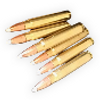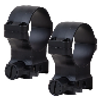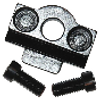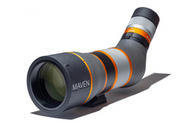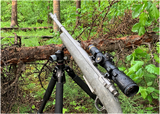
The wind ripped at my sleeves and forced an errant tear from my eye as I struggled to hold my position on the knife edge of a ridge. My two hunters and I had watched a good bull moose evaporate into the brush several hours beforehand and my gut told me he hadn’t gone far after losing sight of him. Elbows on knees, my binocular shook and stirred my field of view into visual soup and my hopes of picking up the bull steadily sank like the afternoon sun.
Minutes later, I screwed my spotting scope onto a tripod shoved deep into the Alaskan tundra and with the more stable platform evening out the gusts of wind, laid eyes on the bull we had hoped to find.

The author packed up and headed down the mountain after a day of moose hunting, spotting scope in tow.
Pack weights dominate conversations for mountain hunters and excess pounds are cut by trimming unnecessary gear. Spotters are a unique tool in a hunter’s arsenal as many people have yet to experience the advantage of one on a backcountry expedition and are quick to leave it at the trailhead. On the other side of the coin, I’ve hunted sheep with guys who won’t bring a toothbrush to save weight but would never dream of ditching their spotting scope.

Moving in and out of cover, this Coues deer was found and field judged through a spotter the last hour of light.
Optics manufacturers like Maven Outdoor Equipment Company are turning out quality mid-size scopes that tip the scale at 40 ounces or less. Maven uses a direct-to-consumer model, cutting out the brick and mortar yet not sacrificing quality, leaving more money and better glass in their customers’ hands. With several options under three pounds like the CS.1A there’s never been a better time to add a spotter to your kit. Read on for some ideas to reap the rewards of a spotter and justify that bit of extra weight.
- 1.Getting comfortable on a vantage point with a good spotting scope is a surefire way to see more game movement. When a hunter is still and watching, animal travel is more unimpeded allowing the hunter to get a much better idea of what game is in their vicinity. This also helps with field judging and stalking as the opportunity to study animals at ease gives more time to formulate a plan.
- 2.A hunter will see more game from a quality spotting scope and tripod than marching through hill and dale every time. A stable platform will help the hunter pick out pieces and parts of game in cover and shade, keeping field of view movement to a minimum. Glassing also allows a person to focus on one task alone and minimizes noise and scent disruption in the area.
- 3.Being able to field judge animals from afar will save time and energy on long backcountry hunts. Horned game like sheep and goats are judged by fractions of an inch or one or two annuli and not having to climb into rifle or archery range until the right animal is found will ensure your legs are as fresh as is reasonable when it’s time to put the hammer down.
- 4.Topography viewed through magnification reveals slight details that the naked eye can skim right over. When paired with an e-mapping program like onX, the two can provide valuable insight into how to use the country to your advantage, whether moving through a drainage system or stalking the buck or bull of a lifetime.
Spotters are a valuable tool that can help find more game, pick routes through country, and aid in leaving some gas in the tank for the moment of truth. If you’re new to the spotting scope world or are looking for a replacement or upgrade, check out Maven and their full line of optics.






